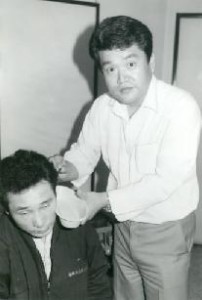7. A Question of Social Responsibility
Feb. 27, 2013
Chapter 4: India, Malaysia, Korea
Part 3: South Korea’s Poisonous Emissions
Part 3: South Korea’s Poisonous Emissions
On our return to Seoul we spoke to doctors involved in radiation medicine. "How can I remain calm when I've been accused of being a tool of the government?" asked Koh Chang-Soon, professor at Seoul National University and chairman of the Korean Society of Nuclear Medicine. Anger and humiliation were apparent in his voice as he told us his version of the incident concerning the government survey.
In August 1989, as part of the Science Ministry medical survey team, the professor had visited Seongsan where he had told the residents that from a medical point of view it would be difficult to imagine that anencephaly could be caused by radiation. Immediately he became the target of abuse from the villagers, and all discussions in Seongsan were over in ten minutes.
"The people there won't even listen unless there's something in it for them," he said disgustedly. "A political solution is the only way to get us out of this mess. Unless we have a guarantee from the residents that they are not going to set out to find fault with any surveys we carry out, I don't see how there can be any cooperation."
Public suspicion appears to be undermining the Science Ministry's efforts to bring the radiation issue under control. "What is being questioned here is the whole issue of the medical profession's duty to society." This was the opinion of Yang Kil-Seung, who runs the Seongsoo Hospital located in Seongdong-gu, an area crowded with small factories in Seoul. Yang is a central figure in an organization of doctors concerned with promoting medical care for the people.
"Where do you suppose the people have got their suspicions from?" he said. "If nobody tells them anything except that there 'are' or 'are not' any effects from radiation, is it any wonder they've lost faith in the medical establishment? We believe that doctors must play a much larger role in educating the public than they do at present."
The group was established in November 1987 by a group of doctors at universities supporting democracy, and other physicians outside the official power structure. The organization has its main office in Seoul, and its 415 members voluntarily provide a consultancy service, carry out surveys, and treat patients with work- and pollution-related illnesses.
The incidents at Kori and Yeonggwang came to light at around the time these doctors began to investigate the health of workers subcontracted to the plants. Directly after media attention was first focused on Seongsan, the Kwangju Jeon Nam branch of the organization announced the findings of its survey: that white blood cell depletion and anemia were abnormally common among the residents of the nearby villages. The results of the survey were seen as an indication that many of the residents of Seongsan were suffering from the initial phase of radiation-related illnesses.
The Seoul headquarters of the group, of which Yang is a member, quickly denied the validity of this result produced by one of their branches, saying that not enough care had been taken in carrying out the survey, and that doctors needed to be especially cautious when working in a field such as radiation because there is still so much that is unknown.
During his time at Seoul National University, Yang was imprisoned for a year for protesting against the martial law instituted by the Park regime. He finally graduated from a British university, and returned to South Korea with the idea of contributing to the improvement of working conditions in the nation's factories. In October 1989 he participated for the first time in a meeting of the International Physicians for the Prevention of Nuclear War (IPPNW) in Hiroshima.
"To be quite honest, most doctors had not paid enough attention to victims of the A-bomb in this country," he said, with a touch of embarrassment. "It may take ten or twenty years for radiation to make its presence known in the body, so we must be careful not to jump to conclusions, but just continue to do research and carry out surveys."
The Korean government aims to construct another forty-four nuclear reactors by the year 2031. The current controversy surrounding atomic energy has been spurred on by the prominence given to nuclear power since the advent of democracy, and the government will need to educate the public and obtain its support if it is to succeed in carrying out this ambitious program of nuclear power development.
The group of doctors intends to continue conducting regular medical examinations and lifestyle surveys of those living around nuclear power plants. An air of secrecy still surrounds the truth about radioactive contamination, but it is Yang's hope that their perseverance will be rewarded with reliable results and the publication of previously unreleased data.








